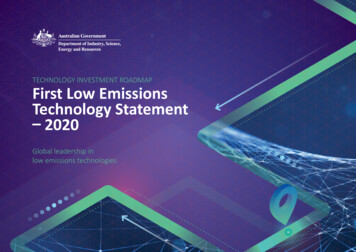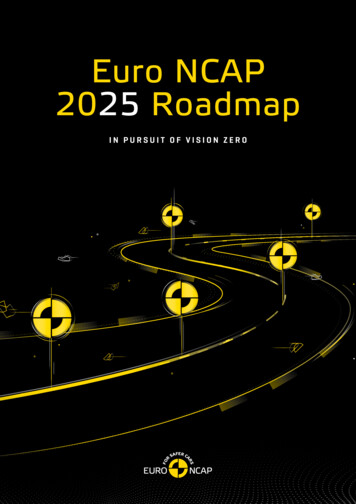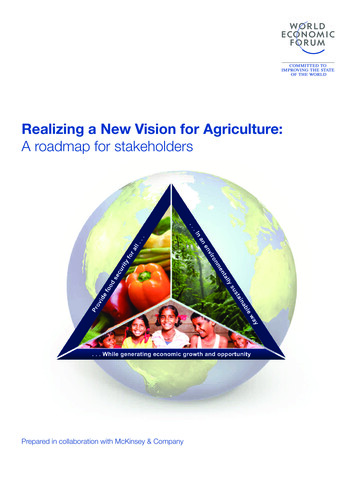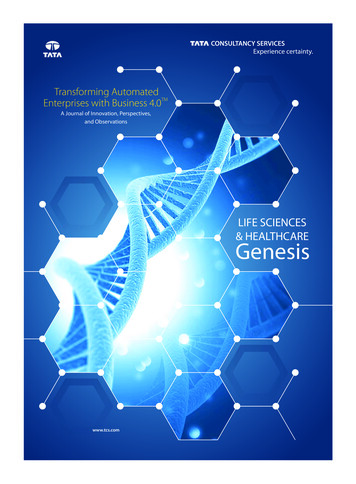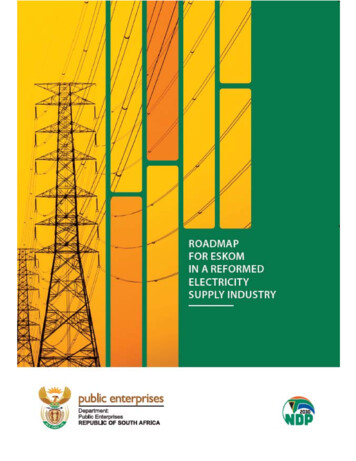
Transcription
ROADMAP FOR ESKOMIN A REFORMED ELECTRICITY SUPPLY INDUSTRY2019
ISBN: 978‐0‐621‐47981‐2RP: 369/2019The Roadmap for Eskom in a reformed Electricity Supply Industry is compiled with the latest available informationfrom departmental and other resources. Some of this information is unaudited or subject to revision.To obtain copies of this document, please contact:Public EnterprisesPrivate Bag X15Hatfield0028Tel: 27 12 4311150The document is also available on the internet at: www.dpe.gov.zaPrinted by ABC Printers
ROADMAP FOR ESKOMIN A REFORMED ELECTRICITY SUPPLY INDUSTRY2019Republic of South AfricaOctober 2019
CONTENTSACRONYMS . iPreface . iiEXECUTIVE SUMMARY . 4INTRODUCTION . 6THE ELECTRICITY CONTEXT . 7SOUTH AFRICA’S ELECTRICITY LANDSCAPE . 7LEGISLATIVE CONTEXT . 7The National Development Plan (NDP). 8The Integrated Energy Plan and the Integrated Resource Plans . 8ESKOM CHALLENGES . 11FINANCIAL . 11GOVERNANCE AND LEADERSHIP. 12OPERATIONAL . 12STRUCTURAL . 14CLIMATE CHANGE COMMITMENTS . 15MOVING ESKOM FROM CRISIS TO STABILITY . 16A NEW BUSINESS MODEL . 16TRANSMISSION . 17Overview . 17The Creation of a Transmission Entity (TE) . 17Proposed Functions of the Transmission Entity . 21Procurement of New Energy . 21Risks and Dependencies . 22Finances . 22Overview . 24GENERATION OF ELECTRICITY . 24New Business Model for the Generation Market . 24Future of Coal . 24DISTRIBUTION . 25The Distribution Environment . 25New Business Model for the Distribution Market . 25ESKOM FINANCIAL SUSTAINABILITY. 26CURRENT STATUS . 26ADDRESSING ESKOM’S DEBT. 26Tariff Implications . 28Wasteful and poorly managed expenditure . 28Coal contracts . 28IPP contracts . 28A new approach to procurement . 29Disposal and Partnerships of Certain Subsidiaries . 29Recovery of outstanding fees . 29Execution of employee related cost savings initiatives . 29Recovery of proceeds of corruption . 29
GOVERNANCE . 31IMPLEMENTING A “JUST TRANSITION” . 32Sustainability for Workers . 32South Africa’s Climate Change Position . 33IRP Commitments . 33Eskom’s Plan for Reducing Emissions. 34Sustainability for communities . 34In the National Interest . 34Smart Grid . 34IMPLEMENTATION OF ROADMAP . 35CONCLUSION . 37ANNEXURES . 38Distribution . 38The flow of electricity . 38South African electricity distribution industry structure . 39Municipalities . 41Generation and the IRP . 42CURRENT GENERATION . 42Generation’s link to the IRP . 44Transmission . 46CURRENT TRANSMISSION BUSINESS . 46The transmission network performance . 47Transmission Entity (TE) roadmap . 48Timelines for Creation of Transmission Entity 100% Owned by Eskom Holdings . 48Eskom Tariffs. 50ECONOMIC REGULATION OF ESKOM’S TARIFF . 50Implementation of MYPD methodology . 50Challenges on implementation of MYPD methodology. 51Solution to implementation of MYPD methodology . 51Municipal Debt. 52Financial sustainability and non‐payment. 52Power Sector Reform Experience: The Case of Vietnam. 53RATIONALE FOR ELECTRICITY INDUSTRY REFORM . 53TIMELINE OF KEY POWER SECTOR REFORMS IN VIETNAM, 1970‐2018 (REFER TO FIGURE 1) . 53VIETNAM’S POWER SECTOR PERFORMANCE . 53LESSONS FROM VIETNAMESE ELECTRICITY REFORM . 53PARTNERS . 56
Roadmap for Eskom in a Reformed Electricity Supply CSOETSMOTDPTETxDepartment of Mineral Resource and EnergyDistributionEnergy Availability FactorEskom Finance CompanyElectricity Supply AgreementsElectricity Supply IndustryFlue Gas DesulphurisationGenerationIntegrated Energy PlanIndependent Power ProducerIntegrated Resource PlanLarge Power UsersLegally Separated Transmission System OperatorMinimum Emission StandardsMulti‐Year Price DeterminationMegavolt AmperesNational Development PlanNational Economic Development and Labour CouncilNational Energy Regulator of South AfricaPhotovoltaicPower Purchase AgreementRegulatory Clearing AccountRenewable Energy Independent Power Producers ProgrammeSouthern African Power PoolState Owned CompanyState Owned EnterpriseTransmission System Market OperatorTechnical Development Plan Planning OfficeTransmission EntityTransmissioni
Roadmap for Eskom in a Reformed Electricity Supply IndustryPREFACEEnergy is changing. Across the globe, emerging technologies, changing customer sensibilities and theeffects of climate change are reshaping how electricity is generated, supplied and consumed. As SouthAfrica responds to these changes, it must also confront the specific challenges that threaten its electricitysupply and constrain its economy.The need to reform the energy sector has been proposed in the past. In the 1998 White Paper on EnergyPolicy, Government had identified some of the reforms required to the electricity supply system,including the restructuring of Eskom, to ensure a reliable, competitive and transparent system.Eskom was created in the 1920s to develop the mineral industrial complex that was taking shapefollowing the discovery of abundant minerals in the late 19th century.Eskom’s vertically integrated structure was appropriate at its inception and served the country well forover 90 years. This configuration is no longer suitable to meet the country’s energy needs and has madethe business susceptible to the kind of problems it has recently experienced, including state capture. Therestructuring of Eskom into three subsidiary businesses – generation, transmission and distribution – isnecessary to reduce the risk that Eskom poses to the country through its dependence on fiscal allocationsand inability to supply the economy with adequate power.The Eskom that must emerge from these reforms must be capable, transparent, accountable, competitiveand world class. Government has a responsibility to mitigate the systemic risk that Eskom has become tothe country. This will start by making the organisation responsible in how it allocates resources to itsoperational activities, and that it is answerable for its performance at all levels.The special paper therefore:1.Outlines actions to overcome the current crisis at Eskom and set it onto a new path of sustainabilitythat will benefit all South Africans for generations to come;2.Defines the key steps in transforming the electricity supply system that are required, including theenergy sources proposed by the 2019 Integrated Resource Plan (IRP);3.Addresses steps to restore Eskom’s finances, including government support;4.Identifies measures to reduce the cost structure of Eskom to enable provision of affordableelectricity; and5.Details the process through which the restructuring of Eskom will take place, including the processthrough which a new transmission entity will be established.The electricity reform process will take place over several years, and will ensure that South Africa has anappropriate electricity supply system capable of responding to the demands of a rapidly evolving world,to which South Africa, if it is to compete, needs to be responsive.The Eskom that shall emerge will be characterised by optimised operations, restructured finances, asustainable business model, and an environmentally responsive electricity system. The business shallimplement appropriate controls to ensure that the recent incidences of irregular, fruitless and wastefulexpenditure are a thing of the past.Importantly the reform of Eskom, through the retiring of end of life power stations and diversification ofprimary energy sources, will minimise the impact on Eskom’s and related industries’ workers andcommunities. In managing the transition, alternative economic activities shall be developed andimplemented to economically sustain communities dependent on the power stations and associated coalmines.The success of the reforms will depend on South Africans fulfilling their civic responsibility to pay forservices consumed. The State, through the executive and elected representatives in all three spheres, andii
Roadmap for Eskom in a Reformed Electricity Supply Industryin collaboration with other social partners such as labour, religious organisations, organised business andcivil society, will address issues of non‐payment of services. The Free Basic Electricity system shall beresourced to adequately cater for indigent families unable to pay.The product of the reform process that is being initiated by the special paper should be an agile Eskomcapable of integrating emerging technologies and inevitable regulatory reforms. It will be an Eskom that isresponsive to market demands through an optimised tariff structure that will provide South Africa withaffordable and reliable electricity. Further, the business will generate from its operations adequate cashto fund its operational and capital programmes.Importantly, the above reforms require leadership and personnel at Eskom that have the technicalcapability and capacity to manage a sophisticated and world class organisation that the aspirations of thecountry and its people demand.To realise these reforms, tough decisions will have to be made and implemented. Government on its owncannot effect the changes required to realise the vision of a sustainable electricity supply system. This is anational effort that will require all institutions, organisations and citizens to play their part.iii
Roadmap for Eskom in a Reformed Electricity Supply IndustryEXECUTIVE SUMMARYIn February 2019, I said that we will make big decisions and take bold steps to embark on a process tofundamentally restructure Eskom and the Electricity Supply Industry. South Africa needs reliable andaffordable electricity.South Africa is blessed with an abundance of energy sources with which to drive economic growth, socialdevelopment and benefit all of its people. Energy security is critical for inclusive economic growth.Government recently announced the Integrated Resource Plan 2019, which sets out the energy mix andthe quantities required to ensure energy security for all South Africans. This Plan provides certainty onthe energy path for the next 10 years. There is a profound commitment to systematically reduce carbonemissions.Equally important is the role of electricity supply security and pricing to promote the competitiveness ofthe South African economy and to bolster industrialisation. Electricity supply at the lowest possible cost iskey to our industrialisation and job creation efforts, as it will enable us to compete better in the globaleconomy. Lowering the cost of electricity is also important for decreasing the cost of living.The current domestic and global conjunctures are the drivers for change in the energy sector and willshape the future of electricity delivery in South Africa, these drivers for change include: Transition from the existing dependence on fossil fuels to the mix of electricity energy sourcesreflected in the IRP 2019; The restructuring of Eskom into Eskom Holdings with three new subsidiaries: Generation,Transmission and Distribution; An intensive focus on radically improving the current operations and eliminating inefficiencies ingeneration; A greater requirement for transparency in the governance of both Eskom Holdings and thesubsidiaries; A rigorous approach to cutting wasteful costs, optimising revenue and resolving the debt burden;and A Just Transition involving all stakeholders to ensure sustainable livelihoods for workers andcommunities.The formation of a Transmission Entity (TE) under Eskom Holdings will foster a competitive market andwill encourage the use of diverse sources of energy.Consideration is being given to create two or more generation subsidiaries to introduce intra‐companycompetition among the generation subsidiaries and drive efficiencies in generation. This will includeEskom’s participation in renewables.The Distribution model of the future will take into account the reliance of municipalities on electricity as asignificant source of revenue. However, many municipalities do not have the technical capacity toeffectively reticulate electricity function, which is a constitutional mandate.There are four key elements in the resolution of Eskom’s financial challenges: significantly improvingoperations, cutting of costs; increasing revenue including collections; and debt management. Discussionshave already commenced with coal producers and participants in the renewables programme to reducethe burden on Eskom. This is the time for all parties to make sacrifices as a contribution to a sustainableenergy future. Greater efficiencies must be obtained from the operations of Eskom as a contribution tobolstering Eskom’s financial position.There is ongoing dialogue with labour and business to implement a Just Transition that can ensureminimal impact on communities and workers. There will be partnerships between Government, labour,4
Roadmap for Eskom in a Reformed Electricity Supply Industrycivil society and business, as agreed to at NEDLAC through the Presidential Working Group on Jobs.Government and Eskom will mobilise the resources needed for the Just Transition.This Paper sets out the bold, actionable steps to mitigate the electricity supply risks, and to put Eskomand the industry on a new path.Among the actions to effectively implement the above vision and transformation include the following: To immediately establish a subsidiary for Transmission within Eskom Holdings and to complete thecurrent planning for the establishment of the generation subsidiaries; Eskom to appoint an executive to drive the implementation of the above plans; Reinforce the existing Eskom transformation team with the necessary skills; Establish a separate Eskom transformation unit reporting directly to the Board; Strengthen the Board and appoint a new CEO in the coming weeks; Radically improve operations, including maintenance of generation plant through strict oversightand consequence management; and Introduce radical cost saving initiatives including renegotiation of coal and IPP contracts.Government and Eskom will ensure that there is sufficient capacity and expertise to oversee theexecution of this Plan. Appropriate structures and processes are being put in place to ensure the effectiveimplementation of this Plan. This will demand higher levels of accountability and transparency fromEskom.This is the largest institutional transformation that South Africa has undertaken in a strategicallyimportant area in recent UtilityCurrently inplaceEskomGXTXDXDPEFunctionalSeparationMarch 2020EskomGXTXDXDPEPhase 3 Legalsubsidiary 2021EskomLegal separation(LTSO)GXTXDX5
Roadmap for Eskom in a Reformed Electricity Supply IndustryINTRODUCTIONThis Paper outlines bold actions to transform Eskom and sets it on a path to sustainable electricity supplyto benefit all South Africans for generations to come. We define the key steps in this transformation;a)b)c)d)e)f)g)Integrated Resource Plan 2019 is our point of departure to embrace the emergence of renewables,gas, nuclear and hydro as set out in the IRP and the adaptation of clean coal practices.Eskom’s finances as they relate to the resolution of the debt, the reduction of costs and the coststructure of Eskom itself.Importantly, we set out both the rationale and the process through which the restructuring of Eskomwill take place and the manner in which a new Transmission Entity will be established.The Paper emphasises South Africa’s climate change commitments to lower our carbon footprint andother emissions.The Paper also focuses on the wellbeing of workers and communities, and it provides Eskomemployees with the assurance that Government will support them and the mining communities toreskill and adapt to the requirements of the new electricity sector as it transforms over the next fewdecadesThe vital role of business – big and small ‐ in the energy transition and its impact on the economy.It advocates the need of a long‐term partnership among all stakeholders to successfully undertakethis transformation.These are significant proposals which will change the character of Eskom and the Electricity SupplyIndustry. We shall strive to involve all stakeholders in this process so that the infrastructure and policydirection put in place over the next few years will have a long‐lasting, positive impact for futuregenerations.Key steps and governance structures that are required to ensure the successful implementation ofEskom’s reforms are defined.6
Roadmap for Eskom in a Reformed Electricity Supply IndustryTHE ELECTRICITY CONTEXTThe global electricity market has shifted from the traditional business model of centrally producing,transmitting and selling to a captive market. Instead, rapidly changing technologies, moderninfrastructure and declining production costs have increased the complexity of managing the supply side.This includes managing a blend of diverse energy sources of traditional and renewable generation,distributed generation including those produced by small and household generators, multiple contractingarrangements and performance monitoring. Demand patterns are also changing with the availability ofmore affordable self‐generation, energy efficiency and storage technologies. Large, unwieldy andvertically integrated institutions such as Eskom struggle to adapt to conditions in a dynamically changingmarket. De‐carbonisation commitments to address climate change are accelerating investment inrenewable infrastructure including new technology such as smart‐grids and digitisation that improvesboth supply and demand management. Large, unwieldy and rigid institutions such as Eskom struggle toadapt to conditions in a dynamically changing marketSouth Africa is blessed with an abundance of energy sources with which to drive economic growth, socialdevelopment and benefit its people from all walks of life.South Africa’s Electricity LandscapeFigure 1: Legislative landscape of the South African Electricity Supply IndustryPolicyTariffsCompliance with legislation and policiesShareholdingLegislative ContextSouth Africa’s energy landscape is regulated through an inter‐linked series of laws, policy documents andposition papers.The White Paper on Energy Policy (1998), supplemented with the White Paper on Renewable Energy in2003, sets out Government’s overarching position on the supply and consumption of energy.Applicable policies include: The National Development Plan; The Integrated Energy Plan (IEP); The Integrated Resource Plans (IRP); The Electricity Pricing Policy (EPP); The Paris Agreement (2016) on Climate Change; The National Energy Act, 2008 (Act No. 34 of 2008);7
Roadmap for Eskom in a Reformed Electricity Supply Industry A range of legislation regulating Nuclear Energy1; and National Environmental Management Air Quality Act (Act.39 of 2004.The National Development Plan (NDP)The National Development Plan (NDP) sets out South Africa’s need to invest in a strong network ofeconomic infrastructure to support the country’s medium and long‐term economic and social objectives.Stable energy infrastructure underpins economic growth and should therefore be robust and extensiveenough to meet the current industrial, commercial and household needs and those of the future.The National Development Plan envisages that by 2030, South Africa’s energy sector will be reliable,efficient and competitive, will be socially equitable through expanded access at affordable tariffs, and willbe environmentally sustainable.To achieve this, the NDP provides a 20‐year planning horizon to roll out electricity infrastructure in linewith Ministerial Determinations issued in terms of Section 34 of the Electricity Regulation Act of 2006.The NDP, together with the Ministerial Determinations, are policy signals investors use to plan theirinvestments in the country’s energy sector.The Integr
restructuring of Eskom into three subsidiary businesses – generation, transmission and distribution – is necessary to reduce the risk that Eskom poses to the country through its dependence on fiscal allocations
